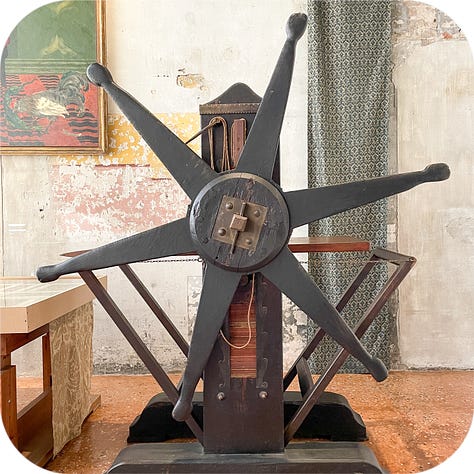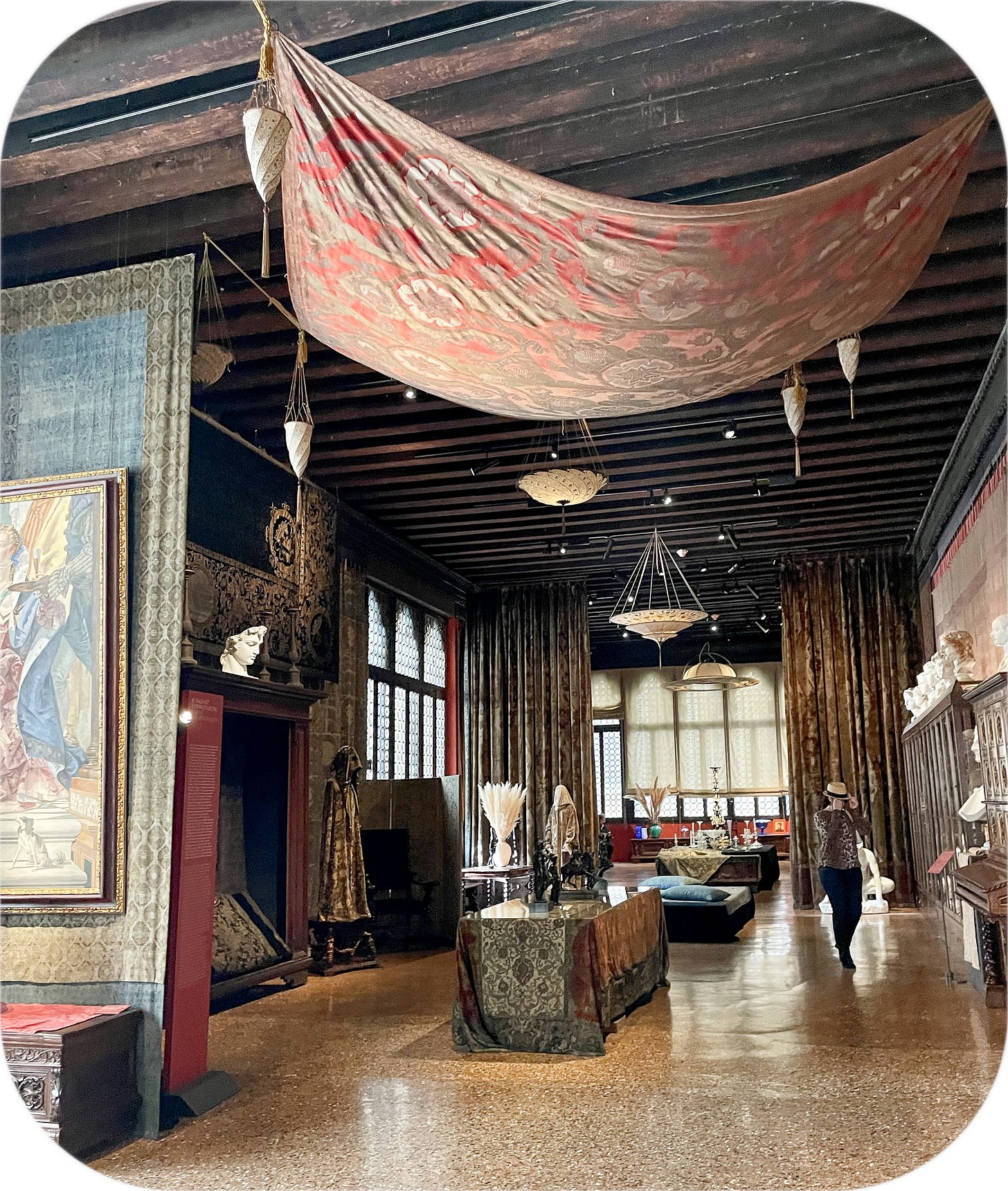The Fortuny Museum, Venice
In which I visit the home and studio of the glorious Mariano Fortuny, and secretly wish they would let me move in.
But I hear that a Venetian artist, called Fortuny, has recovered the secret of the craft, and that before many years have passed women will be able to walk abroad and better still to set at home in brocades as sumptuous as those that Venice adorned for her patrician daughters, with patters brought from the Orient.
-Marcel Proust
{Venice, Italy}
The light in Venice is dazzling.
During the day, the sun shimmers on the Grand Canal, and fills the vast Piazza San Marco with an airy brightness. It illuminates white stone churches and elegant palazzos, and reflects off of the sunglasses of the city’s many tourists.
Behind the sunlit facade, though, there are the in-between spaces: little alleys and sidewalks, endless up-and-down stone staircases and narrow canals…spaces in which throngs of people and skilled gondoliers jostle for position, cool and shadowy spaces with dark corners that fill with fog in the morning, and mysterious spaces that - despite the sun - never seem to get fully bright during.
It is these spaces, the Venice of shadows, that Mariano Fortuny seems to belong.
Inventor. Fabric designer. Fashion designer. Theater designer. Lighting engineer. Photographer. Painter. Sculptor. Etcher. Printer. Entrepreneur. (Handsome devil.)
The Magician of Venice....
Born in Granada, Spain - at the foot of the Alhambra - in 1871, Mariano Fortuny y Madrazo was, in fact, Spanish and not Italian.
His father, who died when Fortuny was just three years old, was one of the most important Spanish painter of his time. His mother came from a long line of painters and artists as well, and was a collector of art and textiles in her own right.
When her husband died, Cecilia de Madrazo moved with her two small children to Paris, where Mariano first learned to paint under the guidance of his maternal grandfather. Fifteen years later, the family moved again. Mariano was 18 years old when he moved to Venice, and he stayed there until his death at the age of 77.
It was in 1898 that Fortuny first moved his painting studio into the top floor of the Palazzo Pesaro Orfei, a neglected 15th-century building that was at the time split up into dozens of artist’s studios and apartments.
As he settled into his new studio, his success as a painter led to commissions for opera and theater sets, including at Milan’s famous La Scala opera house. Immersing himself in the world of theater, he discovered that lighting that had conventionally been used to illuminate theaters wasn’t really doing his sets - or the productions - justice. He developed and patented a system of theater lighting that was based on indirect and reflective light, and lamps that allowed light to be more easily controlled - to allow portions of the stage to be illuminated while others stayed in shadow. The system was eventually utilized by all of the major theaters and opera houses throughout Europe.
…it is not the quantity but the quality of light that makes things visible, and allows the pupil to open properly.
-Mariano Fortuny
Meanwhile, Fortuny acquired space bit by bit in the Palazzo Pesaro Orfei, and slowly started renovations on the structure. By 1906 he owned the entire structure. He demolished walls, so that each floor of the palace was dominated by a large gallery running the length of the space, with bottle glass windows at each end. A series of smaller rooms ran along either side of the galleries - rooms that he used as studios and workrooms and workshops, where he could build lamps and lighting systems, and paint, and experiment in sculpture, photography, etching and printing.
In 1907 he moved in, and the studio became his home, as well - a home he stayed in until his death in 1949.
The Fortuny gown that Albertine was wearing that evening seemed to me the tempting phantom of that invisible Venice. It was overrun by Arab ornamentation, like Venice, like the Venetian palaces hidden like sultan’s wives behind a screen of perforated stone, like the bindings in the Ambrosian library, like the columns from which the oriental birds that symbolized alternately life and death were repeated in the shimmering fabric, of an intense blue which, as my eyes drew nearer, turned into a malleable gold by those same mutations which before an advancing gondola, change into gleaming metal the azure of the Grand Canal.
-Marcel Proust, In Search of Lost Time
Let’s go back in time for a moment, though.
In 1897, while Fortuny was still living in Paris, he met a young artist’s model named Henriette Negrin. By 1902, Henriette had moved to Venice to live with Fortuny, and within a few years after that she became his business partner (and in 1924 his wife).
And although it is the name Fortuny that is famous, it was his partnership with Henrietta that produced the products for which the Fortuny name is known today.
Around 1906 or so, Fortuny started using the techniques that he had mastered in his experiments with lighting and printing and photography, and applied them to fabric. Starting with stenciled silks, and then moving onto velvet, Fortuny created complex and intricate scarves and garments that were inspired not only by the historic textiles in his mother’s collections, but the Eastern textiles that Venice had been importing and selling since it was a major stop on the Silk Road.
Fortuny and Henriette turned several floors of their palazzo into a factory producing beautiful textiles that became scarves, coats, dresses and eventually home goods - wall covering, lamps and table runners.
The intricate scarves and cloaks that Fortuny produced cried out for a simple gown to wear beneath them, and in about 1907 the Delphos gown was born. An icon of fashion design, the gown is simply constructed, but made with pleated silk fabric that was incredibly time-consuming to produce. In 1909 Fortuny patented the machine that was used to make the fabric in Paris, stating on the application:
“This patent is the property of Madame Henriette Brassart (Negrin) who is the inventor. I submitted this patent in my name given the urgency of filing.”
The mystery of Henriette’s method remains a secret, and production of the Delphos gown stopped in 1949, upon Mariano Fortuny’s death. Legend holds that not only did Henriette cease production, she threw Mariano’s original dyes into the Grand Canal, ensuring that no one would ever be able duplicate their dresses.



Henriette donated the Palazzo to the city of Venice when she died in 1965, with the stipulation that the studios be kept as they were. The building was opened as a museum in 1975.
The studios are richly decorated with Fortuny’s paintings, and photographs, his lighting projects and theater models…and everywhere layer upon layer of textiles.
There’s even a taxidermied peacock, and an owl who gives me the side-eye as I walk past him, as if to say “Look at this. Can you believe how lucky I am?”
At first I wonder if I’m the only one who wants to immediately move in upon visiting Fortuny’s home, and then eventually I wonder if it’s possible that there’s anyone who doesn’t want to move in to this masterpiece of a space: a space reflective not only of the artist and polymath who called it home, but of the city that surrounded and inspired him.
PS - If you enjoyed this letter, please consider becoming a subscriber to have The Diary of a Lady Traveler delivered to your inbox. Subscriptions are free, unless you choose otherwise. Absolutely no pressure at all, but if you’d like to support my writing, I’ve added a virtual tip jar as well: you can find the “Buy me a coffee” button below. Thank you for reading!





















I visited last year and had to be practically dragged out. Of course I want to live there! Also, to wear only Fortuny gowns. Glorious, unexpected museum that feels like a secret.
Your piece grabbed my attention of course with the photo of the BOOKS! What a fabulous space to live and work. Yes, I'd move in immediately, and also never leave Venice! Thank you for sharing such a vivid look at the artist AND the space! Wonderful!